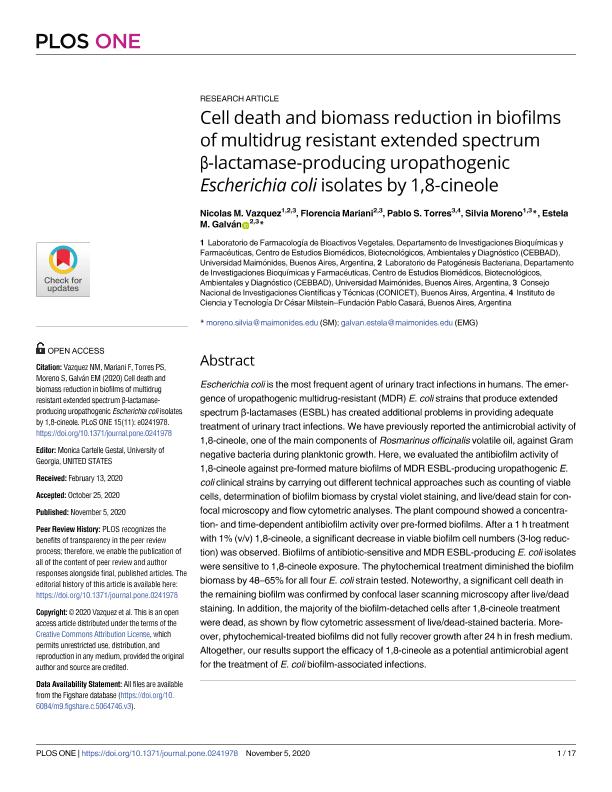Mostrar el registro sencillo del ítem
dc.contributor.author
Vázquez, Nicolás Martín

dc.contributor.author
Mariani, Florencia

dc.contributor.author
Torres, Pablo Sebastian

dc.contributor.author
Moreno, Silvia

dc.contributor.author
Galvan, Estela Maria

dc.date.available
2022-03-22T03:29:41Z
dc.date.issued
2020-11
dc.identifier.citation
Vázquez, Nicolás Martín; Mariani, Florencia; Torres, Pablo Sebastian; Moreno, Silvia; Galvan, Estela Maria; Cell death and biomass reduction in biofilms of multidrug resistant extended spectrum β-lactamase-producing uropathogenic Escherichia coli isolates by 1,8-cineole; Public Library of Science; Plos One; 15; 11; 11-2020; 1-17
dc.identifier.issn
1932-6203
dc.identifier.uri
http://hdl.handle.net/11336/153690
dc.description.abstract
Escherichia coli is the most frequent agent of urinary tract infections in humans. The emergence of uropathogenic multidrug-resistant (MDR) E. coli strains that produce extended spectrum β-lactamases (ESBL) has created additional problems in providing adequate treatment of urinary tract infections. We have previously reported the antimicrobial activity of 1,8-cineole, one of the main components of Rosmarinus officinalis volatile oil, against Gram negative bacteria during planktonic growth. Here, we evaluated the antibiofilm activity of 1,8-cineole against pre-formed mature biofilms of MDR ESBL-producing uropathogenic E. coli clinical strains by carrying out different technical approaches such as counting of viable cells, determination of biofilm biomass by crystal violet staining, and live/dead stain for confocal microscopy and flow cytometric analyses. The plant compound showed a concentration- and time-dependent antibiofilm activity over pre-formed biofilms. After a 1 h treatment with 1% (v/v) 1,8-cineole, a significant decrease in viable biofilm cell numbers (3-log reduction) was observed. Biofilms of antibiotic-sensitive and MDR ESBL-producing E. coli isolates were sensitive to 1,8-cineole exposure. The phytochemical treatment diminished the biofilm biomass by 48-65% for all four E. coli strain tested. Noteworthy, a significant cell death in the remaining biofilm was confirmed by confocal laser scanning microscopy after live/dead staining. In addition, the majority of the biofilm-detached cells after 1,8-cineole treatment were dead, as shown by flow cytometric assessment of live/dead-stained bacteria. Moreover, phytochemical-treated biofilms did not fully recover growth after 24 h in fresh medium. Altogether, our results support the efficacy of 1,8-cineole as a potential antimicrobial agent for the treatment of E. coli biofilm-associated infections.
dc.format
application/pdf
dc.language.iso
eng
dc.publisher
Public Library of Science

dc.rights
info:eu-repo/semantics/openAccess
dc.rights.uri
https://creativecommons.org/licenses/by/2.5/ar/
dc.subject
UROPATHOGENIC ESCHERICHIA COLI
dc.subject
MULTI-DRUG RESISTANCE
dc.subject
EXTENDED SPECTRUM BETA-LACTAMASE PRODUCER
dc.subject
PHYTOCHEMICAL ANTIMICROBIAL ACTIVITY
dc.subject
1,8-CINEOLE
dc.subject
ANTIBIOFILM ACTIVITY
dc.subject.classification
Biología Celular, Microbiología

dc.subject.classification
Ciencias Biológicas

dc.subject.classification
CIENCIAS NATURALES Y EXACTAS

dc.title
Cell death and biomass reduction in biofilms of multidrug resistant extended spectrum β-lactamase-producing uropathogenic Escherichia coli isolates by 1,8-cineole
dc.type
info:eu-repo/semantics/article
dc.type
info:ar-repo/semantics/artículo
dc.type
info:eu-repo/semantics/publishedVersion
dc.date.updated
2022-03-14T21:09:01Z
dc.identifier.eissn
1932-6203
dc.journal.volume
15
dc.journal.number
11
dc.journal.pagination
1-17
dc.journal.pais
Estados Unidos

dc.journal.ciudad
San Francisco
dc.description.fil
Fil: Vázquez, Nicolás Martín. Universidad Maimónides. Área de Investigaciones Biomédicas y Biotecnológicas. Centro de Estudios Biomédicos, Biotecnológicos, Ambientales y de Diagnóstico; Argentina. Consejo Nacional de Investigaciones Científicas y Técnicas; Argentina
dc.description.fil
Fil: Mariani, Florencia. Universidad Maimónides. Área de Investigaciones Biomédicas y Biotecnológicas. Centro de Estudios Biomédicos, Biotecnológicos, Ambientales y de Diagnóstico; Argentina. Consejo Nacional de Investigaciones Científicas y Técnicas; Argentina
dc.description.fil
Fil: Torres, Pablo Sebastian. Consejo Nacional de Investigaciones Científicas y Técnicas. Oficina de Coordinación Administrativa Parque Centenario. Instituto de Ciencia y Tecnología "Dr. César Milstein". Fundación Pablo Cassará. Instituto de Ciencia y Tecnología "Dr. César Milstein"; Argentina
dc.description.fil
Fil: Moreno, Silvia. Universidad Maimónides. Área de Investigaciones Biomédicas y Biotecnológicas. Centro de Estudios Biomédicos, Biotecnológicos, Ambientales y de Diagnóstico; Argentina. Consejo Nacional de Investigaciones Científicas y Técnicas; Argentina
dc.description.fil
Fil: Galvan, Estela Maria. Universidad Maimónides. Área de Investigaciones Biomédicas y Biotecnológicas. Centro de Estudios Biomédicos, Biotecnológicos, Ambientales y de Diagnóstico; Argentina. Consejo Nacional de Investigaciones Científicas y Técnicas; Argentina
dc.journal.title
Plos One

dc.relation.alternativeid
info:eu-repo/semantics/altIdentifier/url/https://journals.plos.org/plosone/article?id=10.1371/journal.pone.0241978
dc.relation.alternativeid
info:eu-repo/semantics/altIdentifier/doi/http://dx.doi.org/10.1371/journal.pone.0241978
Archivos asociados
